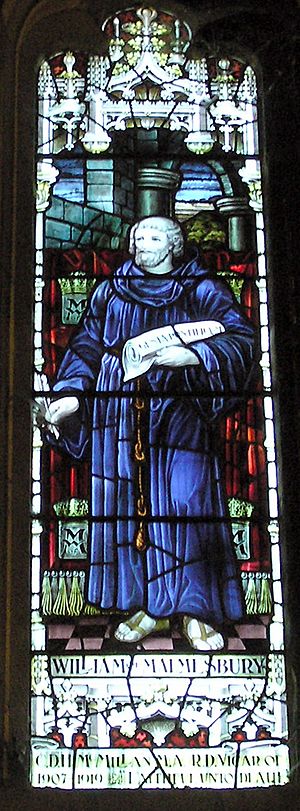Gesta Pontificum Anglorum facts for kids
The Gesta Pontificum Anglorum is a very old history book. Its Latin name means "Deeds of the Bishops of the English." Sometimes people call it The History of the English Bishops. William of Malmesbury, a monk, wrote it in the early 1100s.
This book tells the story of the Church in England. It starts from when Saint Augustine arrived in England in 597 AD. It continues up to the time William wrote it. William started working on it before 1118 and finished the first version around 1125.
William did a lot of research for his book. He used many different sources and his own experiences. The book is special because it is very well organized. It is one of the most important books for learning about the Church in England after the time of Bede.
William believed that the Norman invasion of England was a good thing. He thought it saved the English people. He felt it brought England back into the main European culture. Because of this, he often changed Anglo-Saxon names to sound more Latin.
The History of the English Bishops was quite popular in England. However, it was not as famous as William's other book, the Chronicle of the Kings of England. His book on kings was known across Europe. Still, the bishops' history became the basis for many later Church histories.
Contents
What's Inside the Book?
William's other book, about kings, used the Anglo-Saxon Chronicle as a guide. But for the History of the English Bishops, William had to create his own plan. He organized the book in a very smart way.
He grouped the information by church areas (called dioceses). Then he grouped these dioceses by the old Anglo-Saxon kingdoms they belonged to. For each diocese, William wrote about its bishops and monasteries. He also added other interesting facts he found.
Book One: Kent's Story
This part starts with the main church area of Canterbury. It talks about its first archbishop, Saint Augustine. Then it moves on to the church area of Rochester.
Book Two: East and West
This section covers the old kingdoms of East Anglia, Essex, Sussex, and Wessex. William writes about many church areas here. These include London, Norwich, Winchester, and Salisbury. He also describes twenty-three religious houses (monasteries).
Book Three: The North
This book focuses on the Kingdom of Northumbria. It includes the church areas of York, Lindisfarne, and Durham. William admitted he didn't know much about northern monasteries. He only wrote about those at Wearmouth and Whitby. He also mentioned cool things like the old Roman ruins at Carlisle. He even described a stone-vaulted dining room there.
Book Four: Mercia's Churches
This part covers the Kingdom of Mercia. It talks about the church areas of Worcester, Hereford, Lichfield/Coventry, and Dorchester/Lincoln. William knew this area better than the North. He described nineteen monasteries in this section.
Book Five: William's Home
The last book is all about Malmesbury Abbey. This was the monastery where William lived and worked. He also wrote about the life of its first Abbot, Saint Aldhelm.
How the Book Changed Over Time
One very old copy of the History of the English Bishops is special. It's called Magdalen College, Oxford MS lat. 172. William himself wrote it around 1125. This makes it the oldest surviving book written by an author in England. It's a small book, about the size of a modern paperback.
William kept adding notes and changes to this copy for about ten years. He often removed comments about people he knew. Sadly, some of his notes were cut off by a bookbinder in the 1600s. This is the only old copy where Book Five is complete.
Many copies of the book were made over time. Some were made before William made his changes, and some after. This means there are nineteen different old versions of the book. They help us understand how the text changed over history.
The first time the History of the English Bishops was printed was in 1596. Sir Henry Savile printed it. He used a copy that only had the first four books.


